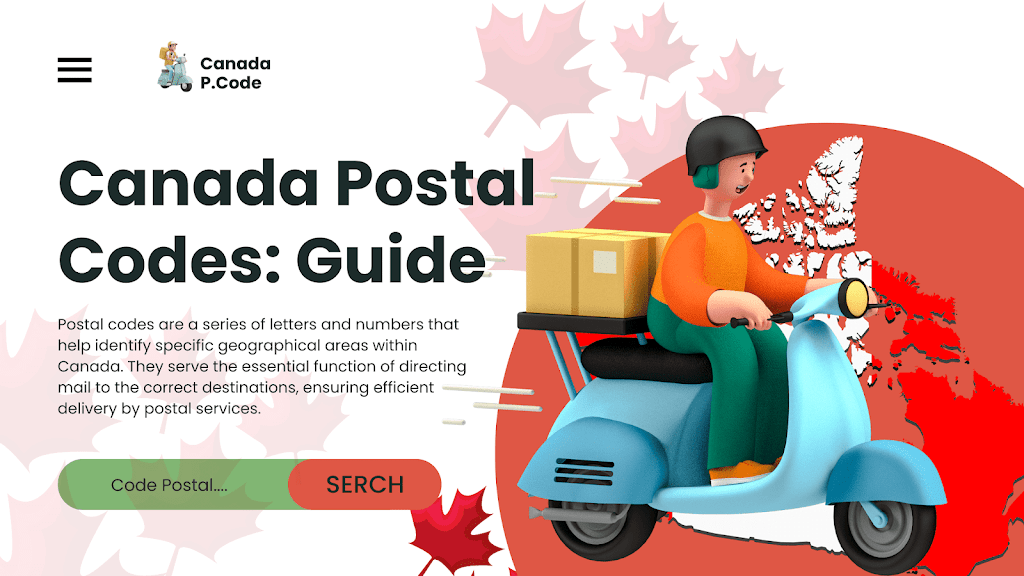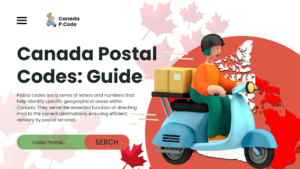I Introduction to Canada Postal Codes
Canada uses a six-character alphanumeric postal code format. The structure is like “A1A 1A1,” where:
The first letter represents a province or territory.
The second character (a digit) represents whether the postal code is rural (0) or urban (1-9).
The third character and the last three characters help identify specific areas and locations.
For example:
M5G 2C3 is a postal code for Toronto, Ontario.
H2X 1Z6 is a postal code for Montreal, Quebec.
To look up specific postal codes, you can use Canada Post’s postal code lookup tool.
Listing postal codes for Big cities in Canada:
Toronto, Ontario: Postal codes start with M (e.g., M4B 1B3)
Vancouver, British Columbia: Postal codes start with V (e.g., V5K 0A1)
Montreal, Quebec: Postal codes start with H (e.g., H2X 1Z6)
Calgary, Alberta: Postal codes start with T (e.g., T2A 0A1)
Ottawa, Ontario: Postal codes also start with K (e.g., K1A 0B1)
A. What Codes?
1. Definition and Purpose
Postal codes are a series of letters and numbers that help identify specific geographical areas within Canada. They serve the essential function of directing mail to the correct destinations, ensuring efficient delivery by postal services.
2. History and Development
The introduction of postal codes in Canada dates back to 1971. Designed to improve mail sorting and delivery efficiency, they evolved from earlier systems that were less organized. Over the decades, postal codes have adapted to the changing landscape of Canada, including population growth and the expansion of urban areas.
3. Importance in Navigation and Deliveries
Postal codes are not just critical for mail delivery; they play a vital role in mapping and navigation. Whether you’re ordering online or locating a friend’s new home, knowing the correct postal code can save time and avoid confusion.
B. Format of Canadian Postal Codes
1. Structure: Letters and Numbers
The Canadian postal code consists of six characters, alternating between letters and numbers. The standard format is “A1A 1A1,” where each character has a specific function.
2. Breakdown of the Format (A1A 1A1)
-
The first character, ‘A,’ represents the province or territory.
-
The second character, ‘1,’ marks a more specific area or municipality.
-
The third character, ‘A,’ indicates a particular delivery route within that area.
-
The spaces separate the forward sortation area (FSA) from the local delivery unit (LDU), which provides unique identifiers for mail.
3. Areas of Coverage Indicated by Postal Codes
Each postal code can point towards multiple delivery points, covering everything from a single building to a neighborhood. This coverage allows postal services to pinpoint locations accurately, regardless of how dense or spread out the population is.
C. Differences Between Postal Codes and Zip Codes
1. Canadian vs. American Systems
While both systems aim to streamline mail delivery, Canadian postal codes are structured differently than American ZIP codes. ZIP codes consist solely of numeric digits, often leading to some confusion among those unfamiliar with the Canadian system.
2. Global Comparisons
Postal codes vary significantly across the globe. In many countries, they also contain both letters and numbers, making them similar to Canada’s format, but still reflecting their unique regional systems.
3. Regional Variations in Use
In Canada, postal codes can significantly differ in usage between urban and rural settings. Urban areas tend to have more densely packed postal codes, while rural areas might have larger gaps in coverage.
II. The Classification of Postal Codes in Canada
A. Types of Postal Codes
1. Forward Sortation Area (FSA)
The FSA reflects the first three characters of the postal code, indicating a specific local region for mail sorting.
2. Local Delivery Unit (LDU)
The last three characters provide more specific delivery details, enabling efficient sorting and delivery at the local level.
3. Unique Postal Codes for Businesses
Many businesses, especially larger corporations, may have unique postal codes that allow for streamlined processing of their mail and packages.
B. Geographic Distribution
1. Urban vs. Rural Postal Codes
Urban areas often have a denser concentration of postal codes, which may lead to more competition among delivery services. Rural postal codes can cover wider areas, frequently leading to longer delivery times.
2. Postal Codes in Remote Areas
In Canada’s remote regions, postal codes may not follow the usual patterns. These areas can present unique delivery challenges, sometimes relying on local knowledge more than numerical codes.
3. Seasonal Changes in Postal Codes
In some regions, especially those that see seasonal migrations, postal codes can change as new areas require different codes to accommodate increased populations.
C. Special Postal Codes
1. Government and Military Codes
Certain postal codes are reserved for government facilities or military bases, ensuring they receive priority in terms of mail delivery.
2. PO Box Specific Codes
PO Boxes have their own unique postal codes, making it easier for postal workers to identify their locations without confusion.
3. Temporary Codes for Events or Festivals
For major events or festivals, temporary postal codes may be introduced, catering to the influx of visitors and facilitating easier deliveries.
III. How Canada Postal Codes are Used
A. Key Applications
1. Mail Delivery Efficiency
Postal codes are a pivotal element in streamlining mail delivery, with distinct codes reducing the chances of misdelivery.
2. E-commerce and Logistics
In our increasingly digital world, postal codes are vital for e-commerce, helping businesses determine shipping costs and delivery times based on location.
3. Emergency Services and Planning
Postal codes assist emergency services in reaching locations quickly. This is especially crucial in large cities where traffic or other obstacles might delay response times.
B. Tools and Resources
1. Online Postal Code Locators
Various online resources allow individuals to find postal codes quickly and efficiently, making the process of locating addresses much simpler.
2. Mapping Tools for Businesses
Many businesses use mapping services integrated with postal code data to optimize delivery routes and enhance customer service.
3. Mobile Applications for Canadians
Several mobile apps offer real-time postal code lookup or mapping capabilities, further assisting Canadians in navigating their postal system.
C. Analyzing Population Distribution
1. Demographic Insights from Postal Codes
Postal codes provide a window into understanding demographics, helping government and businesses make informed decisions based on population density and needs.
2. Urban Planning and Infrastructure Development
Urban planners often rely on postal code data to inform their projects, ensuring that infrastructure meets the needs of residents.
3. Economic Trends Based on Postal Code Data
Businesses can track economic trends and consumer behaviors through postal code analysis, allowing for better market targeting.
IV. Common Challenges and Solutions
A. Issues with Misuse or Misinterpretation
1. Incorrect Coding Leading to Delivery Errors
Simplistic mistakes can cause considerable delays in parcel deliveries, with innocent errors often leading to significant consequences.
2. Fraudulent Use of Postal Codes
In certain cases, individuals may use non-existent or incorrect postal codes to commit fraud or mislead services—making it vital for oversight and education.
3. Challenges for New Residents
Newcomers may find navigating the postal code system daunting without adequate information or resources, emphasizing the need for community resources.
B. Problems in Remote and Rural Areas
1. Infrequent Mail Delivery
Residents in remote areas may experience significant delays in mail delivery, leading to frustration and potential issues with time-sensitive correspondence.
2. Accessing Online Services
Online services, which often rely on postal code input, can be challenging for rural residents who might not have readily available access to the internet.
3. Difficulty in Updating Postal Codes
With changing postal codes due to urban development, residents may find themselves needing to frequently update their address information, which can be inconvenient.
C. Future of Postal Codes
1. Digital Transformation in Addressing
Technology is transforming the way addressing and postal codes are used, with potential shifts toward more dynamic systems emerging.
2. Potential Changes in Code Structure
As population densities shift, postal code structures may need to adapt, reflecting urban expansion and demographic changes.
3. Integration with Geographic Information Systems (GIS)
The future may also see greater integration of postal codes with GIS technologies, improving data accuracy and enhancing delivery services.
V. Tips for Using Canada Postal Codes Effectively
A. Finding the Right Postal Code
1. Using Online Resources
Many tools are available online to help you easily locate the postal code you need, making it simpler to address items correctly.
2. Verifying Codes with Canada Post
When in doubt, reach out to Canada Post or check their website for the most accurate postal code information.
3. Importance for Accurate Addresses
Using the correct postal code is crucial for ensuring your mail reaches its destination efficiently—after all, no one likes delays!
B. Understanding and Using Postal Code Maps
1. How to Read Postal Code Maps
Familiarizing yourself with postal code maps can greatly enhance navigation and deliveries.
2. Utilizing for Travel and Navigation
Incorporating postal codes into your travel plans can help optimize routes and aid in finding destinations.
3. Applications in Real Estate
Real estate professionals often use postal codes to analyze market trends and highlight property values, making them an invaluable tool.
C. Keeping Postal Information Updated
1. Changes in Addresses and Codes
Stay proactive in keeping your address information up-to-date to avoid potential delivery issues.
2. Reporting Issues to Postal Services
If you encounter any issues with your postal code or mail delivery, don’t hesitate to report them to Canada Post to ensure the problem is addressed.
3. Staying Informed About Postal Code Changes
Regularly check for updates from Canada Post, as postal codes can change, and being informed is the best way to avoid miscommunication.
Conclusion
Postal codes are more than just numbers and letters; they are the backbone of an efficient postal system that touches every Canadian’s life. Understanding their significance not only helps with seamless mail delivery but also aids in various aspects of daily life and planning. As we look ahead, it’s essential to embrace potential changes in postal systems to ensure they continue to meet our evolving needs.




1 Comment
celnwh